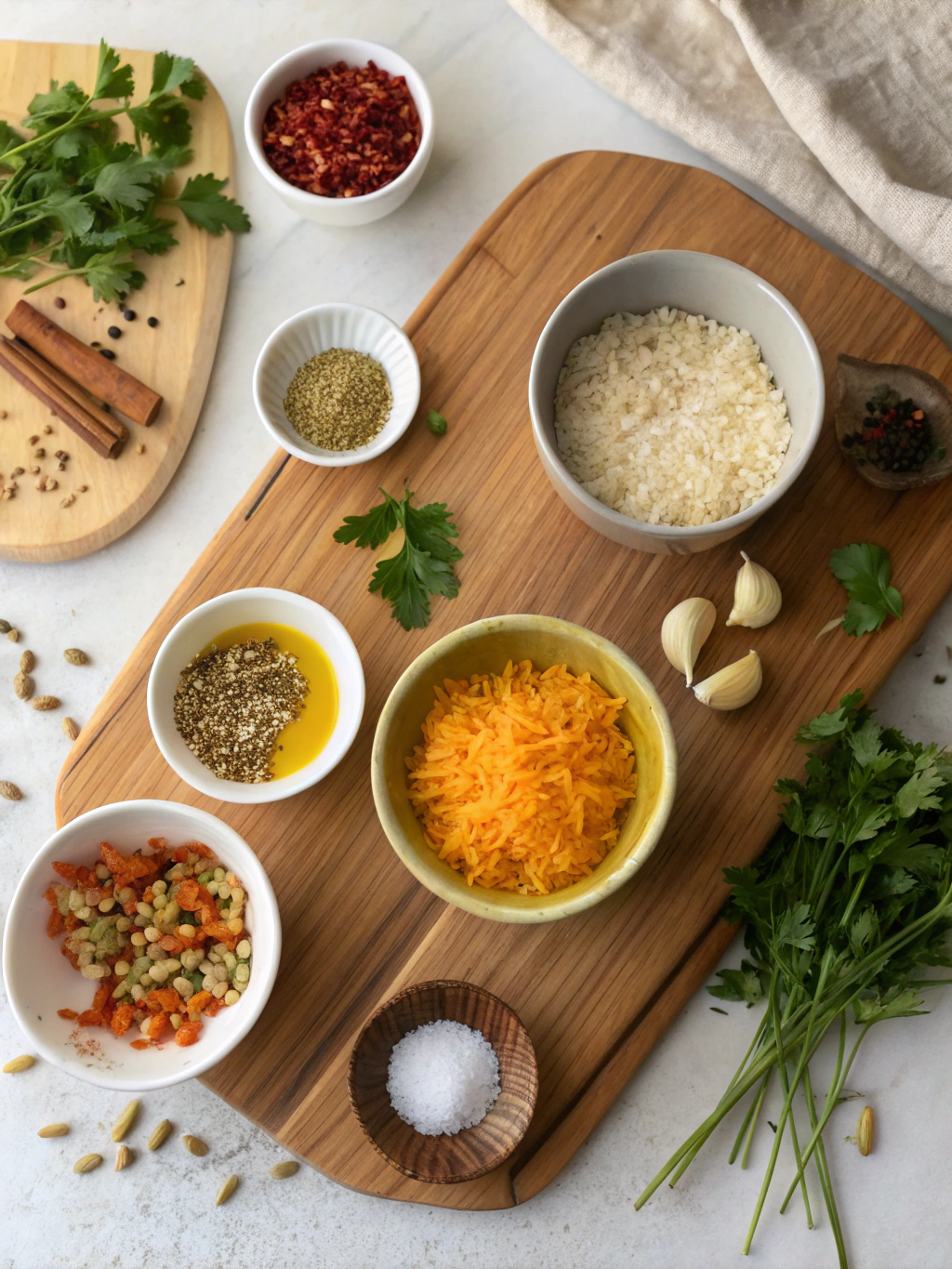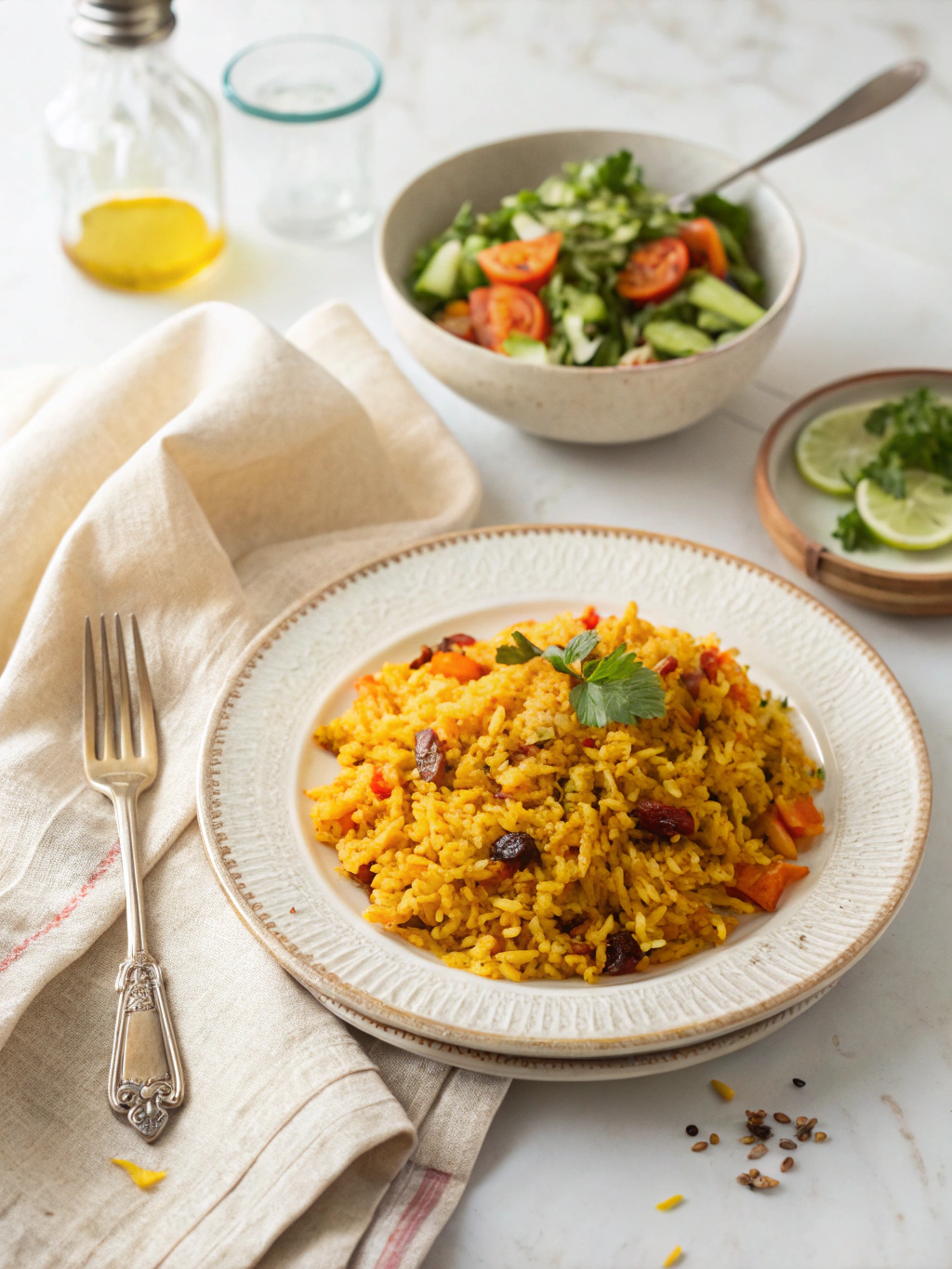“`html
[ez-toc]
Discover the aromatic world of Moroccan cuisine with the exquisite Moroccan Saffron Rice Pilaf. This delightful dish, infused with the delicate flavors of saffron and an ensemble of fragrant spices, brings the essence of Morocco right to your dining table. Understanding the intricacies of this dish can elevate your cooking skills and offer a unique culinary experience cherished by all. For further inspiration, check out this Moroccan Saffron Rice Recipe that complements the rich flavors of the pilaf. Join us as we uncover the secrets to crafting the perfect Moroccan saffron rice, from the basics of the recipe to serving suggestions that will captivate any audience.
Ingredients List
To embark on your Moroccan saffron rice journey, assemble these fresh and aromatic ingredients:
- 2 cups of Basmati rice
- 3 1/2 cups of chicken or vegetable stock
- 1/2 teaspoon of saffron threads
- 3 tablespoons of olive oil
- 1 onion, finely chopped
- 2 cloves of garlic, minced
- 1 cinnamon stick
- 1 teaspoon ground cumin
- 1 teaspoon ground coriander
- Salt and pepper to taste
- 1/4 cup of slivered almonds, toasted
- 1/4 cup of raisins
- Fresh parsley for garnish

Timing
Understanding the timing is crucial for mastering the Moroccan Saffron Rice Pilaf. The preparation time is around 10 minutes, during which you can chop the onions, mince the garlic, and measure the spices. Cooking this delightful dish takes approximately 30 minutes. This total time of 40 minutes ensures that the flavors meld perfectly, creating a harmonious and delicious result. While this dish may seem complex, proper time management allows you to execute it with ease, ensuring that your rice is perfectly cooked and infused with the vibrant saffron aroma. For more tips for perfectly cooking rice, explore our detailed guide.
Step-by-Step Instructions
Step 1: Saffron Preparation
Begin by soaking the saffron threads in two tablespoons of warm water. This allows the saffron to release its vibrant color and unique aroma, which is essential for an authentic Moroccan Saffron Rice Pilaf. For insight into maximizing saffron’s health benefits, read more about the Health Benefits of Saffron. Set it aside as you prepare the remaining ingredients.
Step 2: Sautéing Aromatics
Heat olive oil in a large saucepan over medium heat. Add the finely chopped onions and sauté until translucent, approximately 5 minutes. Stir in the minced garlic, cinnamon stick, ground cumin, and ground coriander, cooking for an additional 2 minutes until the spices become fragrant. This step builds the flavor foundation for your dish. If you’re interested in understanding the use of different spices, check out our comprehensive guide.
Step 3: Toasting and Cooking the Rice
Add the Basmati rice to the saucepan, stirring continuously to ensure it is evenly coated with the spiced oil mixture. Toast the rice for about 2 minutes before pouring in the saffron-infused water and chicken or vegetable stock. Whether you choose to use store-bought or learn how to make your own vegetable stock, it will enhance your dish’s depth. Increase the heat to high and bring to a boil. Once boiling, reduce the heat to low, cover the saucepan with a tight-fitting lid, and let simmer for 15-20 minutes until the rice is tender and the liquid is absorbed.
Step 4: Adding Texture and Flavor
Once the rice has cooked, remove it from the heat and allow it to sit, covered, for an additional 5 minutes. Fluff the rice with a fork, mixing in the toasted slivered almonds and raisins. These additions provide a satisfying texture and enhance the rich flavor profile of the rice pilaf.
Step 5: Final Touches
Transfer the Moroccan Saffron Rice Pilaf to a serving dish, discarding the cinnamon stick. Garnish with fresh parsley for a burst of color and a subtle herbaceous note. Serve immediately and enjoy the journey into Moroccan gastronomy.
Nutritional Info
The Moroccan Saffron Rice Pilaf not only tantalizes your taste buds but also provides significant nutritional value. One serving (approximately 1 cup) contains roughly 250 calories. For detailed information on nutritional content, visit Nutrition Data. The fats from the olive oil and almonds provide heart-healthy unsaturated fats, while the rice is a great source of carbohydrates, sustaining energy levels. The saffron, albeit used in small quantities, offers antioxidant and anti-inflammatory properties. This pilaf also has a moderate amount of protein, thanks to the almonds and stock, contributing to a balanced meal that is both satisfying and nourishing.
Healthier Alternatives
To make a healthier version of the Moroccan Saffron Rice Pilaf, consider substituting brown Basmati rice for a higher fiber content, which aids in digestion and keeps you full longer. Alternatively, cauliflower rice can be used for a low-carb option, though this will alter the texture. For those monitoring sodium intake, opt for low-sodium chicken or vegetable stock. Experiment with adding vegetables like peas or carrots to enhance both the nutritional value and the visual appeal of the dish. These modifications allow you to tailor the recipe to fit your dietary needs without sacrificing flavor.
Serving Suggestions
The versatile nature of the Moroccan Saffron Rice Pilaf makes it an ideal accompaniment for a variety of main courses. Serve it alongside grilled chicken, lamb, or fish to complement the rich flavors. For a vegetarian feast, pair it with roasted vegetables or a fresh salad tossed with lemon and olive oil. This pilaf also holds its own as the main dish at a lively dinner party or family gathering. It not only fills the air with its enticing aroma but also impresses guests with its elegant presentation.

Common Mistakes to Avoid
While preparing Moroccan Saffron Rice Pilaf, several common pitfalls can affect the final dish. First, ensure you do not rinse the Basmati rice too thoroughly, which can remove its natural starches and affect the desired fluffy texture. Following How to Cook Perfect Basmati Rice can guide you in perfecting those grains. Another mistake is overcooking the rice, which can lead to a mushy consistency; instead, keep an eye on the cooking time and remove it from heat when tender. Additionally, using subpar saffron or omitting it altogether can significantly diminish the dish’s authentic flavor, so invest in quality threads. Lastly, do not lift the lid during cooking as it disrupts the steaming process necessary for perfect texture.
Storing Tips
After enjoying your aromatic Moroccan Saffron Rice Pilaf, you may want to store leftovers safely. Allow the rice to cool to room temperature before transferring it into an airtight container. It can be stored in the refrigerator for up to 4 days. For extended storage, place the container in the freezer for up to a month. When reheating, add a splash of stock or water to retain moisture and microwave in short intervals, stirring occasionally to ensure even heating. These storing and reheating methods maintain the dish’s taste and texture, allowing you to enjoy the Moroccan delight anytime.
Conclusion
The secret to


